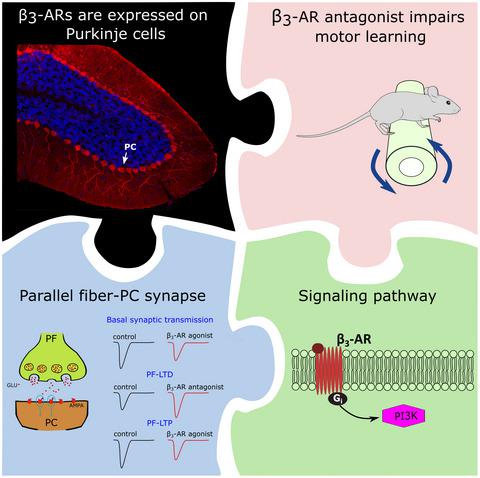当前位置:
X-MOL 学术
›
J. Neurosci. Res.
›
论文详情
Our official English website, www.x-mol.net, welcomes your
feedback! (Note: you will need to create a separate account there.)
Role of β3‐adrenergic receptor in the modulation of synaptic transmission and plasticity in mouse cerebellar cortex
Journal of Neuroscience Research ( IF 2.9 ) Pub Date : 2020-08-17 , DOI: 10.1002/jnr.24712 Pellegrino Lippiello 1 , Eriola Hoxha 2, 3 , Claudia Cristiano 1 , Emilia Malvicini 2, 3 , Adrien Stanley 4 , Roberto Russo 1 , Filippo Tempia 2, 3, 5 , Maria Concetta Miniaci 1
Journal of Neuroscience Research ( IF 2.9 ) Pub Date : 2020-08-17 , DOI: 10.1002/jnr.24712 Pellegrino Lippiello 1 , Eriola Hoxha 2, 3 , Claudia Cristiano 1 , Emilia Malvicini 2, 3 , Adrien Stanley 4 , Roberto Russo 1 , Filippo Tempia 2, 3, 5 , Maria Concetta Miniaci 1
Affiliation

|
Convergent lines of evidence have recently highlighted β3‐adrenoreceptors (ARs) as a potentially critical target in the regulation of nervous and behavioral functions, including memory consolidation, anxiety, and depression. Nevertheless, the role of β3‐ARs in the cerebellum has been never investigated. To address this issue, we first examined the effects of pharmacological manipulation of β3‐ARs on motor learning in mice. We found that blockade of β3‐ARs by SR 59230A impaired the acquisition of the rotarod task with no effect on general locomotion. Since the parallel fiber–Purkinje cell (PF–PC) synapse is considered to be the main cerebellar locus of motor learning, we assessed β3‐AR modulatory action on this synapse as well as its expression in cerebellar slices. We demonstrate, for the first time, a strong expression of β3‐ARs on Purkinje cell soma and dendrites. In addition, whole‐cell patch‐clamp recordings revealed that bath application of β3‐AR agonist CL316,243 depressed the PF–PC excitatory postsynaptic currents via a postsynaptic mechanism mediated by the PI3K signaling pathway. Application of CL316,243 also interfered with the expression of PF long‐term potentiation, whereas SR 59230A prevented the induction of LTD at PF–PC synapse. These results underline the critical role of β3‐AR on cerebellar synaptic transmission and plasticity and provide a new mechanism for adrenergic modulation of motor learning.
中文翻译:

β3-肾上腺素受体在小鼠小脑皮质突触传递和可塑性调节中的作用
最近有越来越多的证据表明,β3-肾上腺素受体(ARs)是调节神经和行为功能(包括记忆巩固,焦虑和抑郁)的潜在关键靶标。然而,从未研究过β3-ARs在小脑中的作用。为了解决这个问题,我们首先研究了β3-ARs的药理作用对小鼠运动学习的影响。我们发现,SR 59230A对β3-AR的阻滞削弱了旋翼任务的获得,而对一般运动没有影响。由于平行纤维-浦肯野细胞(PF-PC)突触被认为是运动学习的主要小脑轨迹,我们评估了β3-AR对这种突触的调节作用及其在小脑切片中的表达。我们第一次展示 β3-ARs在Purkinje细胞体和树突中的强表达 此外,全细胞膜片钳记录显示,β3-AR激动剂CL316,243的沐浴应用通过PI3K信号通路介导的突触后机制抑制了PF-PC兴奋性突触后电流。CL316,243的应用也干扰了PF长期增强的表达,而SR 59230A阻止了PF–PC突触处LTD的诱导。这些结果强调了β3-AR在小脑突触传递和可塑性中的关键作用,并为肾上腺素能调节运动学习提供了新的机制。243通过PI3K信号通路介导的突触后机制抑制了PF-PC兴奋性突触后电流。CL316,243的应用也干扰了PF长期增强的表达,而SR 59230A阻止了PF-PC突触处LTD的诱导。这些结果强调了β3-AR在小脑突触传递和可塑性中的关键作用,并为肾上腺素能调节运动学习提供了新的机制。243通过PI3K信号通路介导的突触后机制抑制了PF-PC兴奋性突触后电流。CL316,243的应用也干扰了PF长期增强的表达,而SR 59230A阻止了PF-PC突触处LTD的诱导。这些结果强调了β3-AR在小脑突触传递和可塑性中的关键作用,并为肾上腺素能调节运动学习提供了新的机制。
更新日期:2020-10-04
中文翻译:

β3-肾上腺素受体在小鼠小脑皮质突触传递和可塑性调节中的作用
最近有越来越多的证据表明,β3-肾上腺素受体(ARs)是调节神经和行为功能(包括记忆巩固,焦虑和抑郁)的潜在关键靶标。然而,从未研究过β3-ARs在小脑中的作用。为了解决这个问题,我们首先研究了β3-ARs的药理作用对小鼠运动学习的影响。我们发现,SR 59230A对β3-AR的阻滞削弱了旋翼任务的获得,而对一般运动没有影响。由于平行纤维-浦肯野细胞(PF-PC)突触被认为是运动学习的主要小脑轨迹,我们评估了β3-AR对这种突触的调节作用及其在小脑切片中的表达。我们第一次展示 β3-ARs在Purkinje细胞体和树突中的强表达 此外,全细胞膜片钳记录显示,β3-AR激动剂CL316,243的沐浴应用通过PI3K信号通路介导的突触后机制抑制了PF-PC兴奋性突触后电流。CL316,243的应用也干扰了PF长期增强的表达,而SR 59230A阻止了PF–PC突触处LTD的诱导。这些结果强调了β3-AR在小脑突触传递和可塑性中的关键作用,并为肾上腺素能调节运动学习提供了新的机制。243通过PI3K信号通路介导的突触后机制抑制了PF-PC兴奋性突触后电流。CL316,243的应用也干扰了PF长期增强的表达,而SR 59230A阻止了PF-PC突触处LTD的诱导。这些结果强调了β3-AR在小脑突触传递和可塑性中的关键作用,并为肾上腺素能调节运动学习提供了新的机制。243通过PI3K信号通路介导的突触后机制抑制了PF-PC兴奋性突触后电流。CL316,243的应用也干扰了PF长期增强的表达,而SR 59230A阻止了PF-PC突触处LTD的诱导。这些结果强调了β3-AR在小脑突触传递和可塑性中的关键作用,并为肾上腺素能调节运动学习提供了新的机制。











































 京公网安备 11010802027423号
京公网安备 11010802027423号